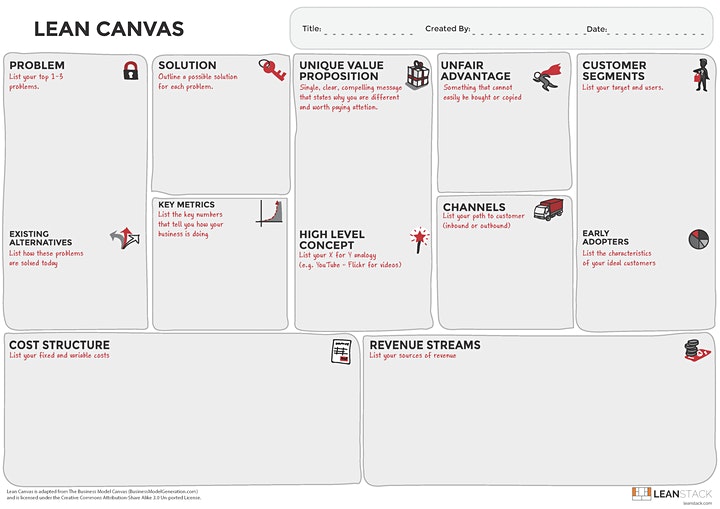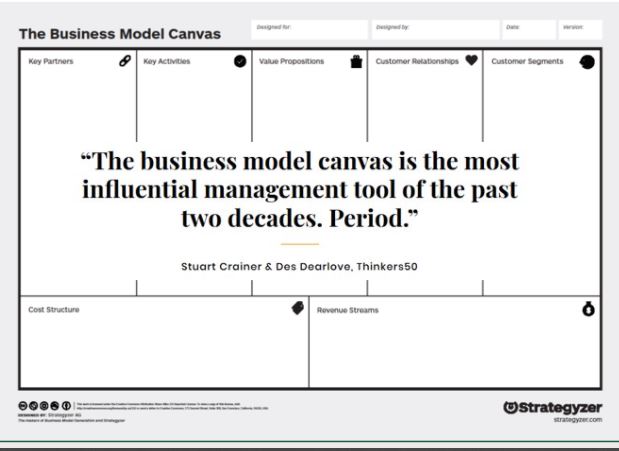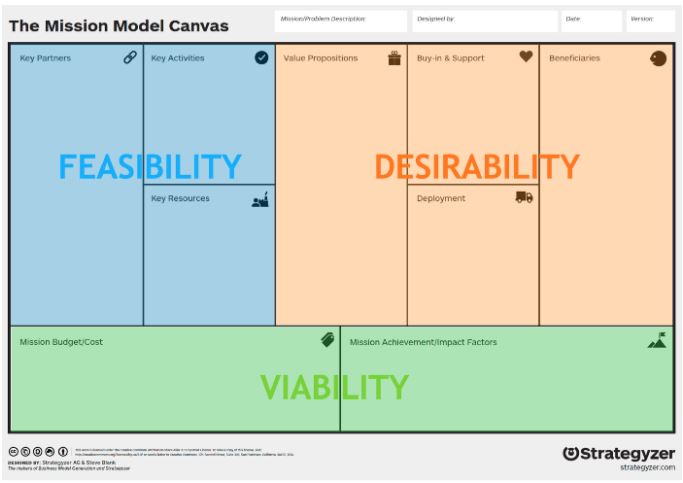Support Page Content
Startup Tools &Templates
From Business Model Canvas to Design Thinking, you'll find useful tools and templates for entrepreneurs here. If you are interested in a deeper dive to understand and utilize the tools, they are featured in our On Demand Entrepreneurship Toolkit Series.
Lean Canvas

Ash Maurya adapted the Business Model Canvas into the Lean Canvas, which is specifically for startups. The Lean Canvas is a one-page, focused business plan for entrepreneurs with emphasis on problems, solutions, key metrics and competitive advantages.
Business Model Canvas
 The Business Model Canvas is a one-page template to strategically map out your business model. The template that includes nine "building blocks" was initially developed by Alexander Osterwalder, entrepreneur, author, speaker, and consultant.
The Business Model Canvas is a one-page template to strategically map out your business model. The template that includes nine "building blocks" was initially developed by Alexander Osterwalder, entrepreneur, author, speaker, and consultant.
Value Proposition Canvas
 This is a tool to help you design a solution that your customers want. Created by Strategyzer, it helps you and your team visualize the value proposition and ensure it ties to your customers' needs.
This is a tool to help you design a solution that your customers want. Created by Strategyzer, it helps you and your team visualize the value proposition and ensure it ties to your customers' needs.
The Value Proposition Canvas enables you to identify customers "gains" and "pains" and “Jobs-to-be-Done” they must complete. It then supports you in mapping the "gain creators" and "pain relievers" that your product and service can provide to create value for your customer.
Mission Model Canvas
 Many entrepreneurs, non-profits, and corporations are taking up the challenge to create social change and create solutions that positively impact the local communities and the world. Social impact business models are different than traditional for profit business models. An example of this is, there are no customers - there are beneficiaries!
Many entrepreneurs, non-profits, and corporations are taking up the challenge to create social change and create solutions that positively impact the local communities and the world. Social impact business models are different than traditional for profit business models. An example of this is, there are no customers - there are beneficiaries!
As a social innovator and entrepreneur you must measure the impact of your mission driven offering - not just the revenue and profit. The leading tool to enable social impact driven ventures is the Mission Model Canvas from Strategyzer and Steve Blank. The Mission Model Canvas can help you better define the social problem you are trying to solve, understand the ecosystem of stakeholders involved, and clarify the key activities needed to diffuse and scale the offering.
Design Thinking Innovation
 Design Thinking Innovation is focused on empathizing with customer's needs by using prototypes and creative solutions that facilitate the further development of products and services. It serves to minimize the risk of innovation by applying an iterative process of learning, testing and refining. Insights are derived from five phases of Empathize, Define, Ideate, Prototype and Test.
Design Thinking Innovation is focused on empathizing with customer's needs by using prototypes and creative solutions that facilitate the further development of products and services. It serves to minimize the risk of innovation by applying an iterative process of learning, testing and refining. Insights are derived from five phases of Empathize, Define, Ideate, Prototype and Test.
Systems Design Thinking
 Beyond design thinking, systems thinking is a way to understand, design, and assess what flows through the value chain, both internally and externally, to ensure integration and consistency between team members, processes, policies, activities, places and resources. Systems thinking is expressed through big picture as well as detailed visualization.
Beyond design thinking, systems thinking is a way to understand, design, and assess what flows through the value chain, both internally and externally, to ensure integration and consistency between team members, processes, policies, activities, places and resources. Systems thinking is expressed through big picture as well as detailed visualization.
The Test Card
![]() With Lean Startup, you need to do customer experiments/tests to validate your business idea before you scale. The Test Card, developed by Alexander Osterwalder of Strategyzer, will allow you to validate your ideas.
With Lean Startup, you need to do customer experiments/tests to validate your business idea before you scale. The Test Card, developed by Alexander Osterwalder of Strategyzer, will allow you to validate your ideas.
The Learning Card
 The Learning Card, developed by Strategyzer, allows you to assess what you have learned from your experiments. These insights help you get clarity necessary to make decisions and take actions. It is used mainly to help you find the the correct business model and value proposition for your idea.
The Learning Card, developed by Strategyzer, allows you to assess what you have learned from your experiments. These insights help you get clarity necessary to make decisions and take actions. It is used mainly to help you find the the correct business model and value proposition for your idea.
Charting Your Company's Future
 A strategic plan typically consists of trying to cobble together data from various stakeholders, adding graphics and budget details, resulting in an unwieldy document. The alternative is to draw a "strategy canvas."
A strategic plan typically consists of trying to cobble together data from various stakeholders, adding graphics and budget details, resulting in an unwieldy document. The alternative is to draw a "strategy canvas."
A strategy canvas shows the competitive factors, both current and future. Secondly, it shows the strategic profile of current and potential competitors. Lastly, it displays the company's strategic profile, the "value curve." This tool was developed by W. Chan Kim and Renée Mauborgne, authors of Blue Ocean Strategy.
Non-Disruptive Creation
When organizations create new markets that displace existing industries and established players, social interest groups and governments are often lobbied to intervene, as the short- to medium-term social disruption that occurs can be very painful in terms of lost jobs and falling earnings, as we have seen in the case of the taxi industry versus Uber and other ride-hailing services. Today, as a result, new rules and regulations are being introduced in an effort to curtail this social cost, which crimps Uber.
Nondisruptive creation, by contrast, largely gets around these costly and hurtful public relations issues for the precise reason that new markets created here produce new jobs that do not replace other existing jobs or companies. So the interest of governments and organizations are in solid alignment, causing less friction and smoother sailing with governments and social interest groups. Nondisruptive creation is a positive-sum approach to innovation and growth.
-- Excerpt from Innovation Matrix, September 10, 2019
Blue Ocean Strategy
"Blue ocean strategy is the simultaneous pursuit of differentiation and low cost to open up a new market space and create new demand. It is about creating and capturing uncontested market space, thereby making the competition irrelevant. It is based on the view that market boundaries and industry structure are not a given and can be reconstructed by the actions and beliefs of industry players."
-- Blue Ocean Strategy Academy